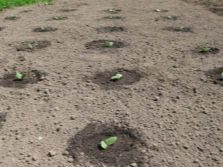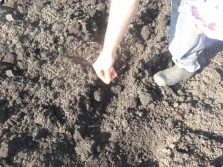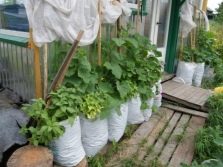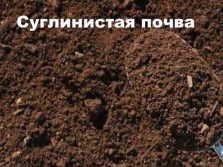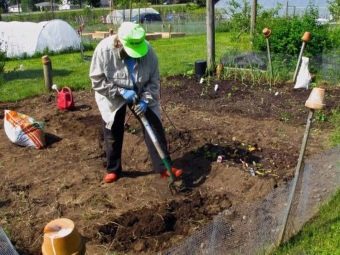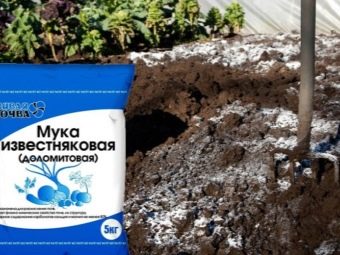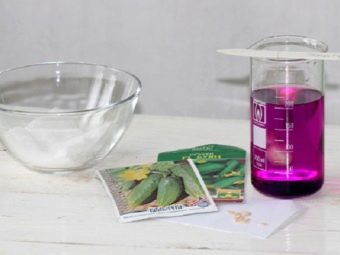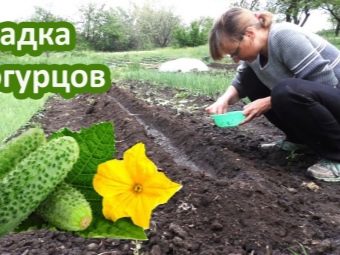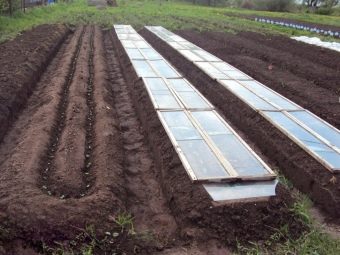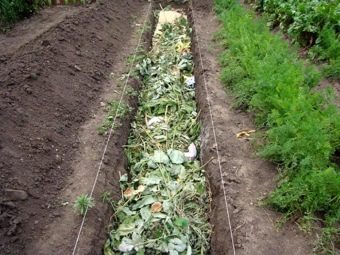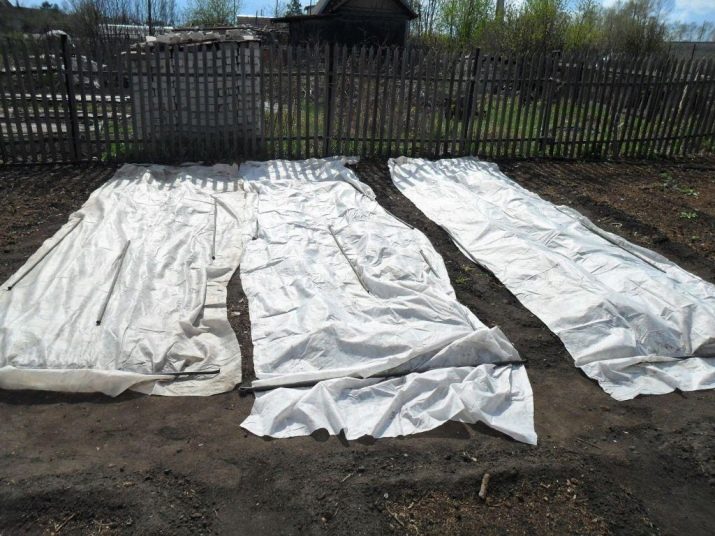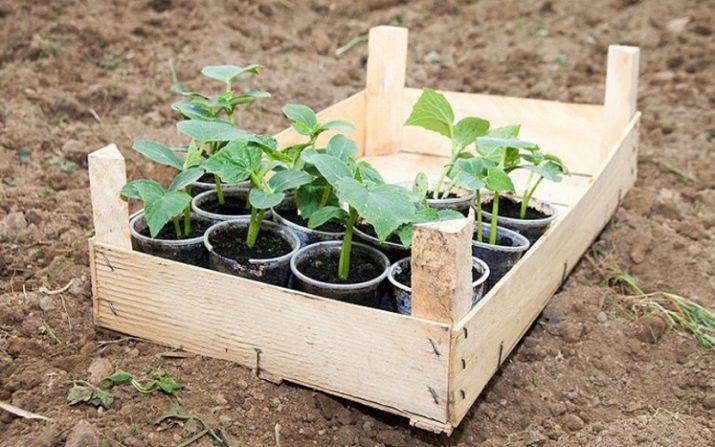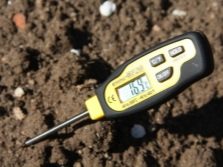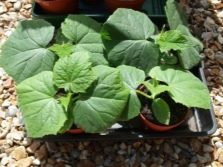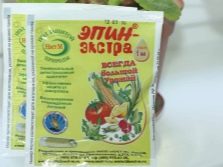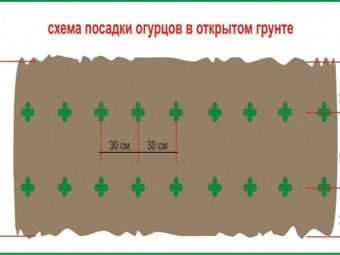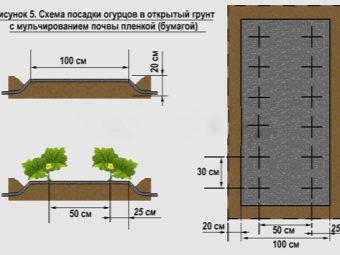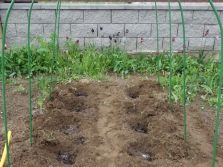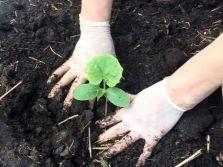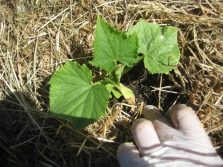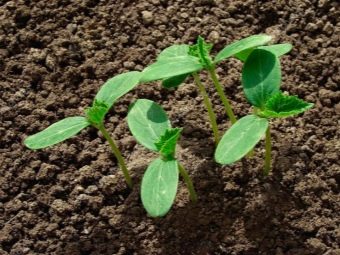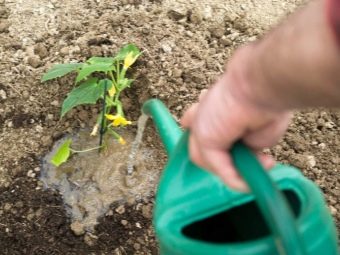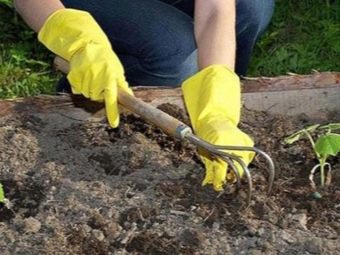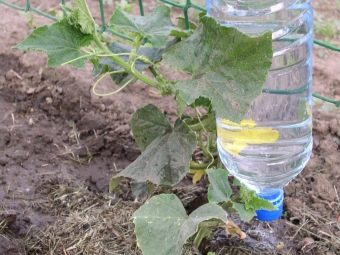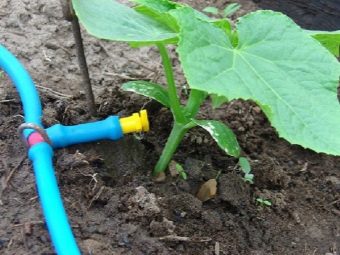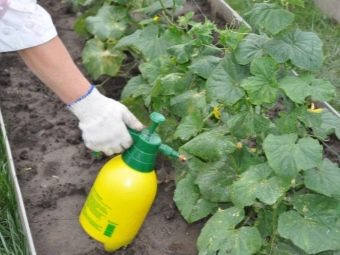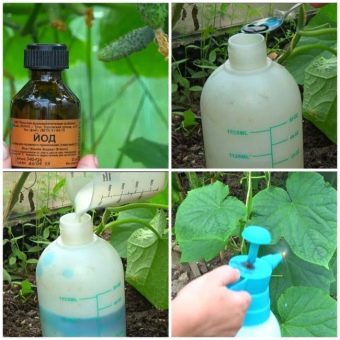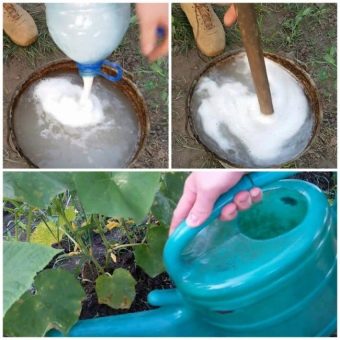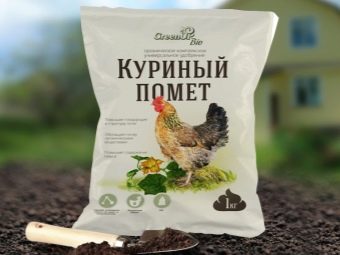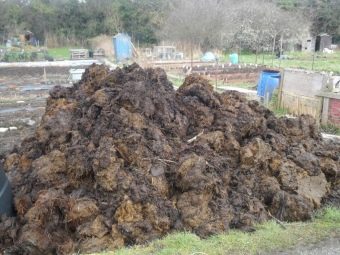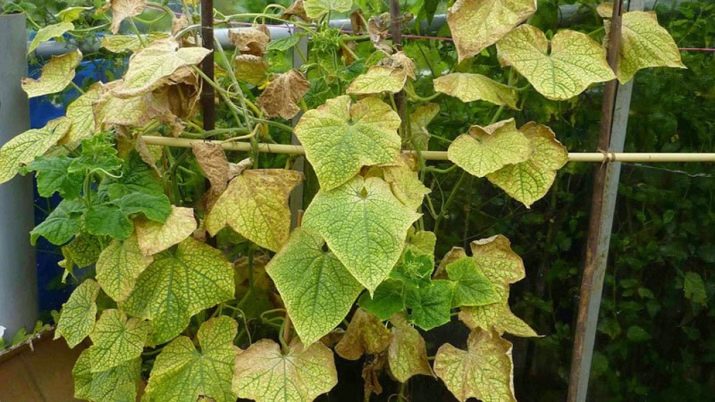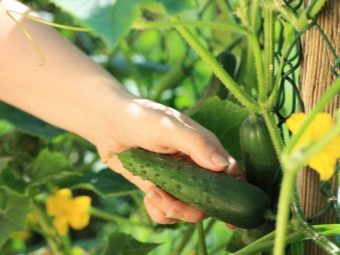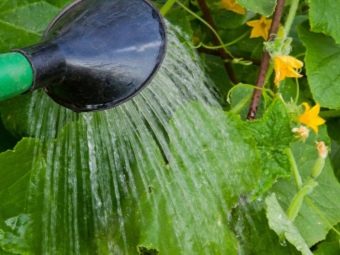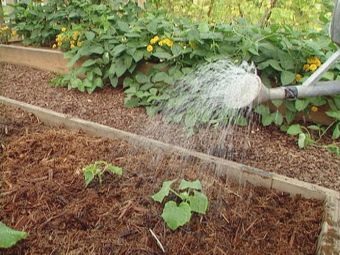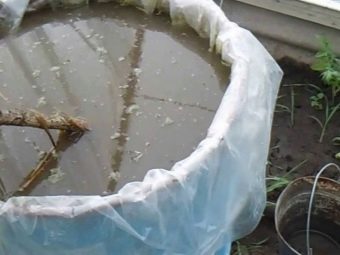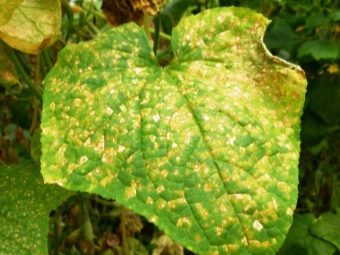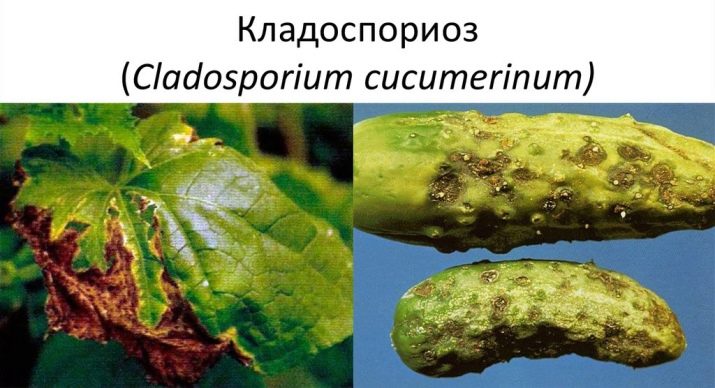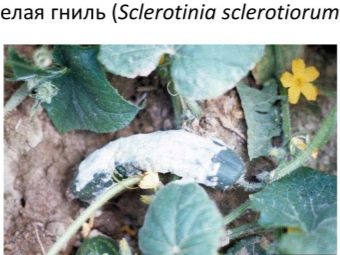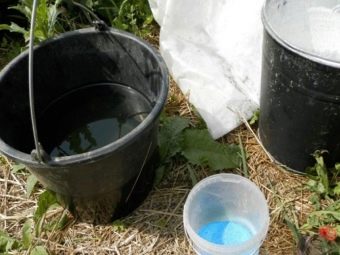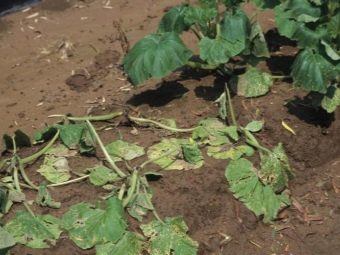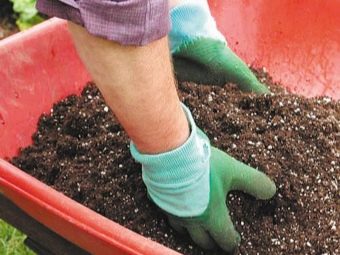Scheme of planting cucumber seedlings in open ground
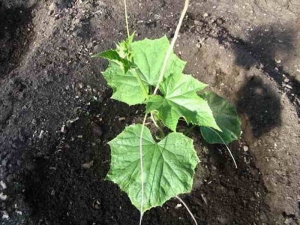
Cucumbers today are considered to be one of the most popular crops for cultivation.This vegetable loves heat and moisture, but it is still quite unpretentious, therefore, even a very experienced gardener can get a bountiful harvest. Therefore, cucumbers are found everywhere in the garden plots of country plots and gardens, they are grown both in open ground and in greenhouses and greenhouses. Planting cucumbers can be two main methods - namely, seeds and seedlings.
However, to get a good harvest of these vegetables, you need to adhere to the timing of planting, and also observe a certain distance between the bushes. The plan of planting cucumber seedlings in open ground is an extremely important point that simply cannot be neglected, in the opposite case, the development of plants will be wrong and their condition will leave much to be desired.
Special features
To plant cucumbers properly, you need to know about the characteristics of their cultivation and the rules that must be followed. The first thing that needs to be done before the seedlings are planted is to select and prepare a place on the plot. Professional agricultural technicians recommend choosing places that are well lit by the sun's rays, but are well protected from the effects of wind and other weather phenomena. As a rule, the optimum place will be a site near any building, for example, a house or a shed in the south or southeast.
As for the soil, cucumbers produce the most abundant crop on sandy or loamy-type soils, since they are saturated with organic substances that positively affect the growth and proper development of this crop. Also, dark soils absorb heat best and, accordingly, it warms up better and earlier, which is very good for cucumbers.
The land where cucumbers will grow should be pretreated with manure. This fertilizer is rich in a substance such as nitrogen, and it is known to promote active fruiting. However, it is very important to maintain a balance of nitrogen and other substances in the soil, primarily potassium, calcium and phosphorus.
Worst of all cucumbers grow on soils with high acidity. Such land will be well treated with alkaline materials, such as lime, in order to achieve a neutral balance. Poor clay and sandy soils are suitable for this agricultural crop, since they are difficult to heat and little fertile. It is also best not to plant this crop in saline soil, but if necessary, such land can be washed.
Currently, there are two main methods of efficient cultivation of cucumbers, namely, seedless way and using cucumber seedlings. But it is better to grow them with seeds - this method is simpler and more affordable and looks more profitable compared to seedlings.
At about the end of May, the time begins when the seed can be planted, and it usually ends in early June. Before sowing the bed, the seeds need to be thoroughly heated, as the heated seeds give more stable shoots and begin to bear fruit sooner. In addition, before planting, seeds are soaked in a solution from water, superphosphate, nitrate and manganese.
A portion of dry seeds is added to the swollen cucumber seeds, after which the seeds are sown with this mixture. This approach ensures that cucumbers will sprout, because if the early seedlings die, others will grow in their place - from dry seeds. Seeds are placed in the grooves at a distance of approximately four centimeters, and the furrows themselves are dug out about half a meter from each other.
Under normal conditions, about 50 grams of cucumber seeds, which need to be planted into the ground to a depth of about two centimeters, will be per square meter. It is necessary to plant seeds only in the wet soil. After landing, it is important to closely monitor the emergence of the first shoots, because if there are nests of birds nearby, they will be in danger.
Timing
Immediately it should be said that there is simply no absolutely exact date for planting seedlings or cucumber seeds, on which days to plant vegetables is determined solely on the basis of the experience of a particular vegetable grower. Many choose the most favorable days based on some personal preferences or even on the lunar calendar. Also, do not be too serious about the recommendations that can be found on packages of seeds - they can only be taken as general advice.
The time when it is necessary to plant this agricultural crop is due to many factors at once. The most important of them is, first of all, the method of planting, as this can be used for seeds or seedlings. Then you need to take into account the climatic conditions of the region, because cucumbers are a culture that loves light and heat and needs enough moisture.
When planting cucumber seedlings in southern latitudes, you can focus on the middle or the end of April. Accordingly, the more to the north there will be a landing site, the further this period will be postponed. If spring comes early, then sowing is done faster, and, accordingly, on the contrary, if it comes late, then sowing should be somewhat delayed. If the seeds are planted in cold, cold soil, some of them will rot, and as a result, seedlings will be very rare.
In northern latitudes, where climatic conditions are quite severe, cucumbers are usually planted in open ground only in May or in the first weeks of June. Also known is the method of speeding up the planting of seeds and seedlings, which consists in warming the ridges - thus, cucumbers can be planted earlier by about two to three weeks.
To achieve high yields, local cucumber varieties, stored for two or three years, are planted. Of these, it is possible to form plants in which flowers of the female sex will appear somewhat earlier. In southern latitudes, cucumbers can be sown in two or three stages at intervals of approximately two weeks.
Experienced vegetable growers and gardeners consider the end of the first decade of June to be the final term for planting this agricultural crop in open soil. Later, planting cucumbers is extremely not recommended, except that we are talking about seeds already germinated - they can be planted a little later. If the ground is protected with a film, then the first week of May will be the best time to land, and if not, then the end of this month.
Cucumbers need to be planted only in heated soil and it is best if its temperature is equal to 16 degrees of heat. Despite the fact that this vegetable is very fond of heat, when the air temperature reaches 27 degrees, plants will need to create a shelter that provides shade.
Seedlings are planted in the phase of two or three true leaves only after the arrival of heat, when the frost has definitely not returned.
If during the planting season there will be hot weather, then it will be best to hold this event in the evening.
How to plant?
After three weeks after the cucumber seeds hatch, the seedlings will be ready to be planted in open ground. It is important that at this time the soil has time to warm up to at least 12 degrees of heat to a depth of at least 10 centimeters. The time when disembarking is made varies depending on many factors, however, on average, this will be the second week of May, if a film cover is used, and the beginning of the first month of summer, if not used. But these are only indicative dates, which vary considerably from region to region.
It is very important to conduct a step-by-step series of preparatory activities before planting cucumbers. The most important thing is to properly harden seedlings and accustom them to normal life in cool and windy weather, as well as to the effects of ultraviolet radiation.In addition, before planting cucumbers, they can be treated with professional products like Epina to prevent damage by pathogens and various infections.
The land where cucumbers will grow should be fertile, quite loose and able to effectively retain water. This culture has a number of features, among which there is a small and weak root system, because of which organic feed is introduced strictly into the landing pits. Although it will not be very deep, it will decompose under the influence of the environment and emit a large amount of heat, which, in turn, will help agriculture to grow and develop faster.
It should be noted that it is important to choose the right place for the beds so that it is well illuminated by the rays of the sun and not blown heavily by the wind. The beds themselves need to be made so wide that it can be reached from either side without much effort. Planting is usually done in a staggered manner and no more than two rows, since it is this scheme that will allow future bushes to get the necessary amount of sunlight. Between seedlings observed distance of about half a meter. So the planting density will be about 3-4 plants per square meter for varieties of tall type and 5-6 plants on the same area for bush plants.
It is good to make beds for cucumbers where cultures such as onions, tomatoes or cabbage used to grow. It is not necessary to plant cucumber seedlings there, where previously the pumpkin family grew. Before disembarking, wells are dug in advance, into which some water is poured, as well as organic fertilizers. It is best suited for this cow dung or compost, which then need to be sprinkled on top of a small amount of earth.
Holes for cucumber seedlings should be deepened to a distance equal to the height of the pot, where it was grown before. The seedling comes from the tank along with the substrate, and if it grows in a peat pot, you can plant it in the hole directly with the tank. Seedlings are planted in the hole very carefully, so as not to damage the root system of the plant. It is important to remember that when planting, in no case should the sub-seminal chase of the plant be buried.
A newly planted seedling needs to be watered with approximately one liter of water, and it is best to do this with a special watering can with a sieve, since otherwise there is a chance to erode the soil. Then you need to make mulch, which is well suited for dried grass or straw - this will help the moisture to linger in the ground. Cucumbers are a crop that is usually tied to a support because it is a climbing plant.
Care rules
After sprouting cucumber seedlings during the formation of the first true leaves, experienced farmers usually begin to thin out the beds. Most often, this procedure is done in one or two stages. If the thinning is carried out only once, the costs will be significantly less, however, this approach is fraught with the death of a certain number of bushes, respectively, shoots will be quite rare. It will be optimal to leave two plants in the well at once, and then, when the bushes at least get a little stronger, repeat this procedure and leave one plant at a time.
Thinning on ordinary plots should be done in such a way that between plants there should be about 12 centimeters for early ripening varieties and up to 30 centimeters for late and mid-season cucumbers. In the northern latitudes, where in cold weather the bushes do not have time to gain a significant mass, a somewhat larger thickening is allowed.
In the southern regions when growing zoned cucumbers with a distance of more than half a meter between rows, thinning is done so that there will be at least 20 centimeters of space between the bushes. If the distance between the rows reaches a meter, then 15 centimeters between the plants will suffice.
Also important types of care for cucumber seedlings in the open field can be easily called loosening and weeding. It is possible to start the treatment of areas between rows as soon as the first shoots appear - such an approach will help to achieve the desired indicator of soil looseness and promptly eliminate weeds. It is also undesirable to form a soil crust before the seedlings grow, and therefore harrowing must be done across the rows with cucumbers.
At the same time, weeds that grow individually are removed, and the plants pile up a little at the time of the first loosening. In the same way, it is necessary to keep the land clean and free from weeds, until the cucumbers are fully ripe.
Despite the seeming simplicity, watering cucumbers is a rather delicate event with a lot of subtleties and nuances. At different times, this agriculture needs a different amount of moisture, which must be correctly calculated for each growth period. First, for plants, the optimum moisture content will be about 75%, during the period of active fruiting, it will reach 85%, and at the final stage of the growing season - 80%.
As you know, cucumber is a crop that is extremely susceptible to dry air - during drought, the plant simply will not develop. For this reason, if the season is hot, it is recommended to carry out frequent watering with a small amount of water. Shrubs that grow in the open field, water every eight days in the southern regions and every two weeks in the northern latitudes. In hot weather, watering intervals can be reduced to 5-6 days. Thus, the average number of irrigations per season will be about 15 for extremely dry weather, about 10 for the usual southern climate and about 8 for temperate latitudes.
Be sure to water cucumbers with water at room temperature. If the water is too cold or hot, then the processes necessary for the normal functioning of the vegetable may be disturbed, and then a good harvest can be forgotten. It is necessary to stock up in advance with warm water in case of hot weather.
You can water cucumbers with a watering can, a hose connected to the water supply system, or even a special sprinkler. On the land plots located in the southern latitudes, it effectively shows itself to be watered along furrows that have been pre-equipped specially for this purpose. Sprinkling will be a bad way to water, because moisture will simply be lost due to intense evaporation processes.
At present, professional breeders and amateur vegetable growers have developed quite a large number of cucumber varieties that can survive even very hot weather - the main thing is to water them at least once a week. Accordingly, the cultivation of such a culture does not require a significant investment of time. Nevertheless, even if drought-resistant varieties grow on the site, it is important to understand that this vegetable will show the best results in any case with abundant watering. Then its fruits will not be bitter, and the harvest will be maximum.
In order to get a good harvest, agronomists recommend to “feed” cucumbers at least three times per season. You can feed the plants with both mineral and organic fertilizers. Of course, every gardener has his own methods, but some recommendations should be taken into account.
There are two types of dressing - root and foliar. Root should be used only in very warm summers, since at high temperatures the roots develop better and absorb fertilizer better. It is better to carry out feeding of this type after watering, in the evening.
Off-root dressing should be used in the event that the summer was cool and overcast. In this weather, the roots will not be able to assimilate all the mineral components. In this case, it is better to spray the leaves. It is necessary to spray fertilizer in the evening, so the drops will last longer on the surface and the plant will have time to assimilate all the useful substances.
The first feeding is best carried out 15 days after planting cucumbers. The second should be carried out when the plant begins to bloom, the third - during the beginning of fruiting. It is better to fix the result with one more top dressing in order to prolong the fruiting period and get a richer harvest.
Fertilize cucumbers can be organic:
- fresh chicken droppings;
- slurry;
- manure;
- infusion of fresh herbs;
- infusion of refined hay.
Mineral fertilizers:
- solution of urea and superphosphate;
- ammonium nitrate with the addition of superphosphate and potassium salt;
- ammophos;
- potassium nitrate with the addition of superphosphate;
- ash;
- boric acid;
- soda
It should be remembered that feeding with ashes can be carried out at any stage of plant development. Also do not forget about the condition of your soil. If your harvest is always healthy and rich, then do not oversaturate the soil with fertilizer. In this case, you can confine one or two supplements organic matter.
Disease prevention
Many gardeners are confident that if they grow cucumbers on their own, then the plant is much less likely to get sick. But in fact, it turns out that gardeners sometimes provoke diseases themselves, even without realizing it. The main source of cucumber disease is various fungi, bacteria and viruses. But there are other factors:
- violation of agrotechnical methods of cultivation;
- crop failure;
- contaminated soil with a lack of mineral elements.
Any reason of the above can cause disease in a cucumber. Of course, it is better to deal with prevention first, than with complex treatment. But to prevent the disease, you need to be able to recognize it.
If a spotted bloom with a white tint forms on the bushes during its cucumber growth, it is a fungal disease called powdery mildew. Places affected by this disease can quickly spread throughout the plant. Subsequently, the individual parts of the vegetable will turn yellow and die off. Because of this, the bush will not be able to give enough fruits, and sometimes even die.
The most favorable conditions for the spread of this disease is cold, wet weather. Its development may cease at a constant temperature of over twenty degrees Celsius. Often powdery mildew causes a lack of moisture, and therefore it is necessary to ensure that cucumber bushes are regularly and abundantly watered.
One of the main measures to prevent disease is crop rotation, since this agricultural crop is not recommended to plant at the previous growth place for at least four more seasons. You must also not forget to harvest in a timely manner from the site, as well as eliminate all sorts of organic residues. In addition, growers are advised to do watering only with the help of a warm liquid.
If you notice the first signs of powdery mildew, you need to act immediately to save the crop. It is necessary to immediately spray the plant with a special preparation. If non-hybrid varieties are grown, it is better to spray the next harvest even before the onset of the disease in order to prevent it.
There are also techniques proven by the experience of generations, they are suitable for those farmers who do not want to use chemicals. You can treat plants with a weak infusion of cow dung. For this, it is mixed with water in a ratio of one to three and infused for three days. After the fluid must be drained and add three liters of cold running water.
You can also prepare a solution of sour milk and water. It is likewise infused and filtered, after which they can process vegetables once every seven days. Soda is another good way to combat powdery mildew. For the preparation of soda-based products in a ten-liter bucket of water, you need to dissolve two tablespoons of soda and 50 grams of household soap. This tool can safely handle the beds once every five days.
When yellow spots appear in large numbers on cucumber bushes, the plant is affected by peronosporosis. Immediately after the onset of the stain is rapidly added in size. The leaves acquire a brownish tint, and then dry and die. Perinospora plant gets sick, regardless of whether it is young or adult.
The causative agent of this disease is considered a fungus. At the first visual signs of damage by peronospora, you need to stop watering it and treat the damaged cucumbers with a special remedy. After processing, it is better to cover the crop with film. For prevention, it is better to periodically process the culture with a weak serum-based solution.
If the bushes and fruits form spots of a light green color - this is a cladosporia disease. Its rapid development inevitably leads to darkening and a significant increase in ulcers already on the third day.
Cladosporiosis, which in the environment of professional agrotechnists is known as brown olive spot, usually affects plants under conditions of low temperatures or when it drops. The fungus can spread along with precipitation, wind, or even with watering, as water can be contaminated. This infection also tends to damage the soil and stay there for a long time.
If you find signs of cladosporia, you should immediately stop watering cucumbers for at least 5 days, since excessive moisture only helps the fungus to spread. You will also need to spray the plants with special preparations.
When white formations appear on cucumbers, it is most likely sclerotinia, which is otherwise called white rot. After some time, the white spots will become much darker, to the extent that their color becomes black.
The causative agent of sclerotinia is a fungus that infects the land where cucumbers grow. It can begin to spread rapidly when the ground is too flooded with water and there is an excess of moisture in the atmosphere. In order to prevent the occurrence of sclerotinia, even when planting cucumbers, one should adhere to the rules of agricultural engineering and plant them not too thickly.
But if you have already discovered this disease, then first of all you need to remove the plants affected by white rot. Healthy areas of the bush, especially where there are cuts, can be treated with lime or ground charcoal for a quick recovery. For the purpose of effective prophylaxis, it is necessary to feed plants with nutritious preparations, for the preparation of which vitriol and zinc can be used.
If the cucumber bush quickly fades and dries, then the plant is likely to become ill with root rot. To verify this, you need to pull out the root and inspect it. If the structure is loose, and its color is red, then the cucumber was struck with rot. Among vegetable growers, it is believed that root rot occurs most often in comparison with other diseases, and it is also the most dangerous.
Root rot cucumbers get sick if they are improperly grown. Among the main reasons one can single out too high a temperature, as well as an excess of moisture in the ground. You can reduce the likelihood of root rot damage by following the rules of watering, as well as with the use of a regular prequicker.
If the plant is already sick, you should immediately contribute to the emergence of new healthy roots. Around the affected cucumber should scatter a new layer of fertile soil. Then cut the bottom leaves and bury them in the same ground. Watering should be done around the root and only with warm water.
But if the plant has already died, you should immediately dig it along with the ground. This will save the rest of the harvest, as it will not allow the disease to spread. On this place it is worth filling up the new fertile earth, and all the equipment used for this purpose is processed in a soap solution.
One of the reasons for the yellowing of leaves is sudden temperature fluctuations.If at night the temperature of the air began to fall sharply, then the harvest should be covered with film. But the main reason may be a lack of potassium. This problem will be harder to fight.
For preventive purposes, do not be lazy to treat plants with infusion of ash. In one liter of water it is necessary to dissolve 75 grams of ash, and leave for two days to infuse. It is also useful to feed cucumbers infusion on the basis of onion peel. To do this, in ten liters of warm water, add two tablespoons of onion peel and boil. When the solution is infused, water the plant with it, taking into account the consumption of one liter per bush.
If you follow all the rules for growing and care, it will not be difficult to grow a good crop of cucumbers. It will be enough to plant the seedlings correctly, water the bushes from time to time, fertilize and carry out preventive measures, especially during the period when fruits are formed. This stimulates fruiting and reduces the likelihood of various unpleasant diseases. All this will help to get a decent harvest of a truly amazing vegetable.
For how to plant cucumbers in open ground, see the video below.


